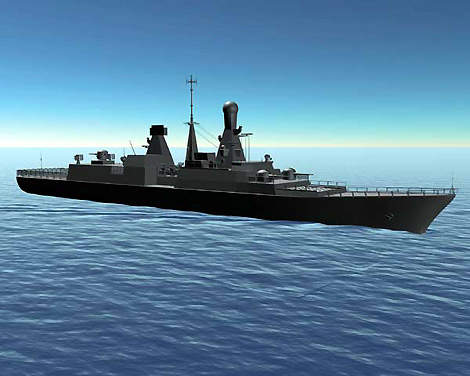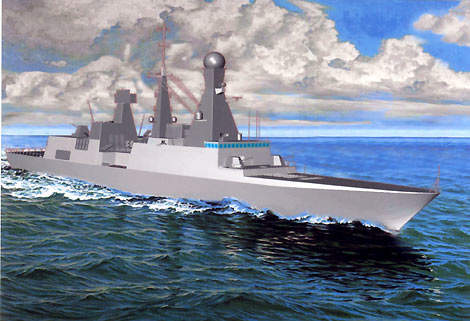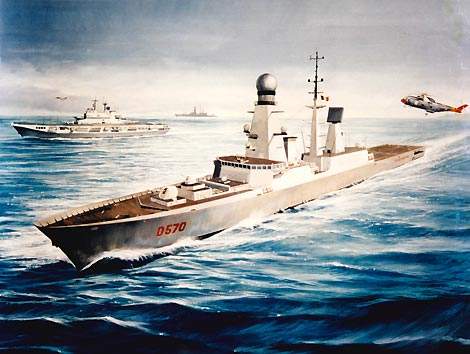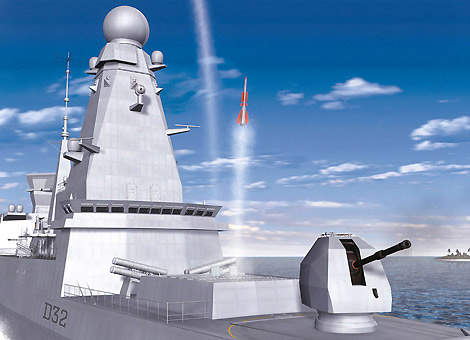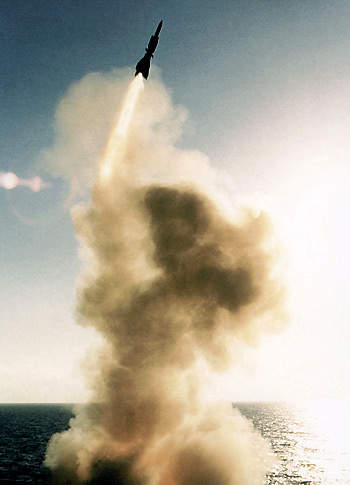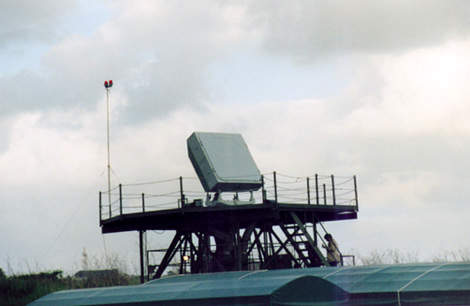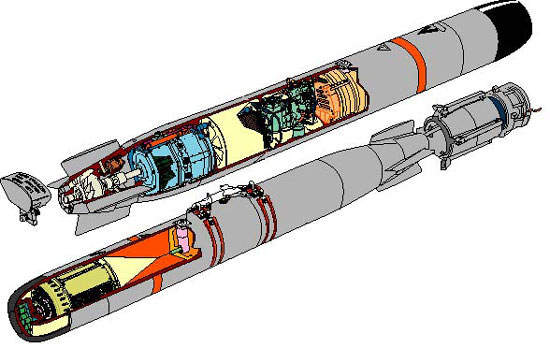Italy and France each ordered two Horizon Class anti-air warfare (AAW) frigates in October 2000. The frigates are being built by Horizon SAS, a joint venture between Armaris (Thales and DCN) of France and Orrizonte Sistemi Navali (Fincantieri and Finmeccanica) of Italy.
In April 2007, DCN became DCNS. This followed an agreement in which Thales became a 25% shareholder in the new company and DCN acquired the naval business of Thales France (excluding naval equipment). DCNS is now the sole owner of Armaris.
The first French vessel, Forbin, began construction in April 2002 and was launched in March 2005. It was delivered in 2006 and commissioned in June 2008. The second, Chevalier Paul, started construction in December 2003, was launched in July 2006. It was commissioned in June 2009 and entered service in December 2009.
The first Italian vessel, Andrea Doria, began construction in July 2002, was launched in October 2005 and delivered in December 2007 for commissioning in 2009. The second, Caio Duilio, began building in September 2003, was launched in October 2007 and commissioned in April 2009.
The French frigates replace the Suffren and Duquesnes frigates, while the Italian vessels replace the Audace and Ardito.
The original Horizon project was a three-nation initiative, involving Italy, France and the UK, to build a new design of air defence ship. The UK government withdrew from the programme in 1999. France and Italy signed a new memorandum of understanding in September 2000 confirming the joint development of the Horizon.
The main requirement for the frigates is to escort and protect task forces or merchant shipping. The main missions of the Horizon frigate are to provide local area or extended cover against saturation missile attacks and to escort and protect carrier groups. The ship also has powerful anti-submarine and anti-air self defence.
The ship is configured for rapid deployment and extended range and endurance and can carry sufficient fuel, water and stores for an endurance of 45 days at sea between replenishments. The ship can attain a speed of 29kt and, at a cruising speed of 18kt, has a range of over 7,000nm.
Command and control
The command and control system has been developed by Eurosysnav, a joint venture company set up by Armaris and Finmeccanica, and is based on the Senit 8 combat data system. Alenia Marconi Systems, now Selex Sistemi Integrati, supplies the data transfer system (DTS).
NICCO Communications SAS, a joint venture between Thales Communications and Marconi Mobile SpA, developed the fully integrated communications system.
The communications suite includes two link 11 and one link 16 high-capacity digital information distribution systems. Selex and Sagem supplied the integrated navigation system.
The Selex NA 25 provides fire control for the 76mm guns. The ships are also equipped with the SAGEM Vampire MB infrared search and track system (IRST), which operates in both 3-5 and 8-12-micron wavebands.
Frigate missiles
Horizon frigates are armed with the PAAMS principal anti-air missile system. PAAMS is a tri-national programme involving France, Italy and the UK. The contract for series production was placed in November 2003. The prime contractor is Europaams SAS, a joint venture company two-thirds owned by Eurosam (MBDA and Thales) and one-third by the UKAMS subsidiary of MBDA. The system is also being fitted on UK Royal Navy Type 45 frigates.
The DCNS Sylver A50 vertical launch system within PAAMS, installed immediately forward of the two guns towards the bow deck, has 48 cells for both the Aster 15 and Aster 30 missiles. The Sylver launcher ensures that each round is aligned to within 1mrad. The maximum rate of fire is up to six rounds a second.
The Aster missile carries an inertial computer with datalink and an active J-band Doppler radar seeker. Aster 30 has a range of 100km, Aster 15 a range of 30km. The missile has manoeuvrability of up to 62g, achieved through the use of the PIF/PAF guidance system.
The Italian frigates are fitted with two quadruple launchers for the MBDA Teseo (Otomat) mk3 surface-to-surface missile, which has a range of up to 55km. The quadruple launchers are installed aiming one to port and one to starboard on the missile deck between the ship’s two masts. The missile uses command updated inertial guidance and reaches high subsonic speed, Mach 0.9.
Horizon Class guns
The three Oto Melara 76mm / 62 Super Rapid guns are installed as a pair on the foredeck immediately forward of the bridge and a single gun installed on the hangar overlooking the helicopter deck at the aft of the ship. Two Oto Melara Mod 503 25mm / 80 guns are installed one to port and one to starboard.
Frigate torpedoes
The ship has two twin torpedo launchers for Eurotorp Mu 90 lightweight torpedoes. Eurotorp is a consortium formed by Whitehead Alenia Sistemi Subacquei (WASS), DCN and Thales.
Mu 90 has a directed energy warhead and a range of 12,000m at maximum speed and 25,000m at minimum speed.
Countermeasures
The electronic warfare suite is developed by the Sigen Consortium (Thales Systèmes Aéroportés SA of France and Elettronica SpA of Italy) and characterised by the latest generation of radar ESM (electronic support measures) and ECM (electronic countermeasures) architectures and implementation of new digital and microwave technologies.
The radar ESM component features very high sensitivity, very high accuracy direction finding and broadband digital receivers. The radar ECM component is based on phased array solid-state technology and features high specific transmitted power, fast reaction, multi-threats engagement capability and complete programmability of coherent and not coherent jamming techniques, due to the implementation of multiple broadband digital radio frequency memory (DRFM).
The French frigates are equipped with Sagem Défense Sécurité (formerly EADS Defence & Electronics) new-generation Dagaie system (NGDS). Each system consists of a pair of two-axis launchers with 12 infrared, radar or acoustic decoys. Italian vessels have Oto Melara / Selex SCLAR-H decoy launchers for chaff and infrared flares.
Horizon is equipped with a SLAT torpedo defence system which is also installed on the French and Italian aircraft carriers, the Charles de Gaulle and the Garibaldi. SLAT has been developed by EUROSLAT, a consortium consisting of WASS (Whitehead Alenia Sistemi Subaqua), DCNS and Thales Underwater Systems.
Helicopters
The helicopter deck at the bow of the ship has a single landing spot for a 10t helicopter, for example the NH90 or EH101 Merlin helicopter. The stabilisation system allows the ship’s helicopter to be deployed and the combat systems operated in high sea states.
Horizon Class sensors
The large round radome of the Selex EMPAR multi-function phased array radar (primary sensor for PAAMS), operating at G-band (4GHz to 6GHz), is mounted at the top of the forward mast. The Thales / Selex S1850M air and surface search radar, operating at D-band (1GHz to 2GHz) is mounted at the top of the aft mast.
The Selex RASS surface search radar, covering E and F bands (2GHz to 3GHz, and 3GHz to 4GHz), is mounted on the forward face of the mast. The Selex SPN 753(V)4 navigation radar operates at I-band from 8GHz to 10GHz. Selex also provides the SIR-R/S interrogation friend or foe (IFF) system.
Thales Underwater Systems and WASS was awarded the contract to supply the hull-mounted TMS 4110CL sonar which operates at medium frequency in active search and attack mode. TMS 4110CL uses a cylindrical array and advanced processing.
Propulsion
The ship’s propulsion system is configured in a combined diesel or gas (CODOG) arrangement with two GE LM2500 / Avio gas turbines rated at 53MW and two SEMT Pielstick diesel engines rated at 8MW. The engines drive two shafts with constant-pitch propellers.

